Several powerful spices in your kitchen can naturally extend food's shelf life while enhancing flavor. Cloves, black pepper, garlic, cinnamon, and thyme stand out as nature's top preservatives, with antimicrobial properties that fight harmful bacteria. You'll get the best results by combining spices – try mixing thyme and rosemary to preserve meat for up to 60 days, or blend cumin with black pepper for vegetable dishes. Store your spices in airtight, dark containers at room temperature to maintain their preservative power. Ancient civilizations mastered these preservation techniques, and modern science confirms their effectiveness. There's a whole world of natural preservation methods waiting to transform your food storage approach.
The Power of Salt Preservation
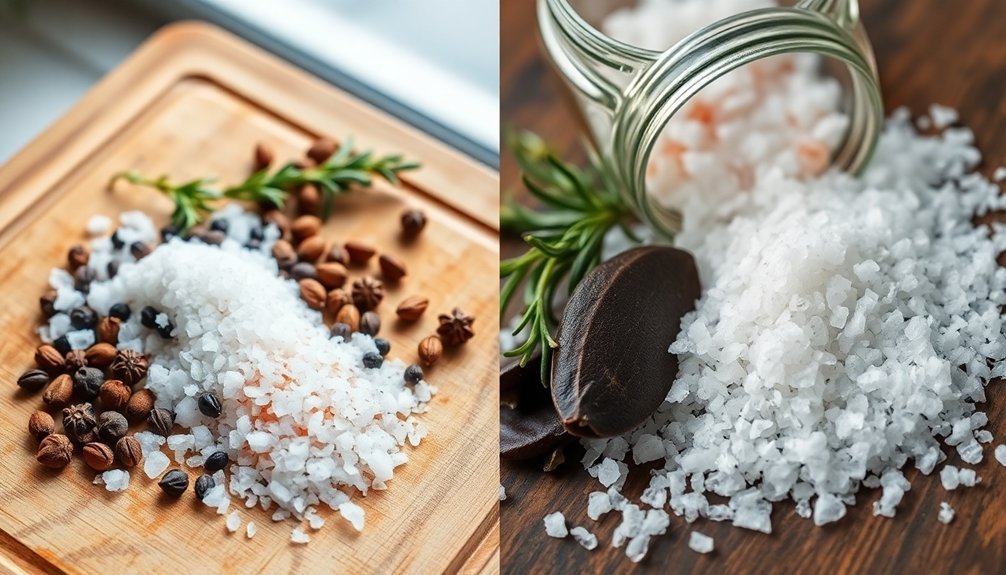
The preservation power of salt varies by food type.
Salt serves as a powerful chemical preservative agent by drawing out moisture and inhibiting microbial growth.
You'll find that properly salted meats can last for months, while salt-preserved fish might keep for years under the right conditions.
When you're preserving vegetables like cucumbers or cabbage, you'll create pickles or sauerkraut that can last for extended periods.
For best results, store your salt-preserved foods in airtight containers in a cool, dry place, and they'll maintain their quality for months or even years.
Common Kitchen Spices as Preservatives
Beyond salt's remarkable preservation abilities, your kitchen likely contains several powerful spices that can extend food freshness naturally.
Black pepper, a common staple, works effectively in preserving jams, pickles, and candies through its antimicrobial and antifungal properties. You'll find ginger equally valuable, as it prevents bacterial growth while offering anti-carcinogenic benefits. Using spices offers a healthier preservation alternative compared to chemical additives.
When you're preserving raw meats, don't overlook mustard seeds, which can keep tuna and beef fresh for hours by preventing toxic bacterial growth.
Cumin's antioxidant properties help prevent food oxidation, while cloves offer robust antimicrobial protection alongside their distinctive flavor.
You can easily incorporate these spices into your preservation methods.
Try combining whole or ground black pepper in your pickles, or add ginger powder to restrict bacterial formation in various dishes. For traditional Indian-style preservation, you'll benefit from mustard seeds' dual role as both preservative and flavoring agent.
When you're looking to enhance both preservation and taste, consider mixing coriander with other spices.
These readily available ingredients don't just preserve your food—they'll also add flavor, color, and numerous health benefits to your dishes.
Ancient Techniques Still Work Today
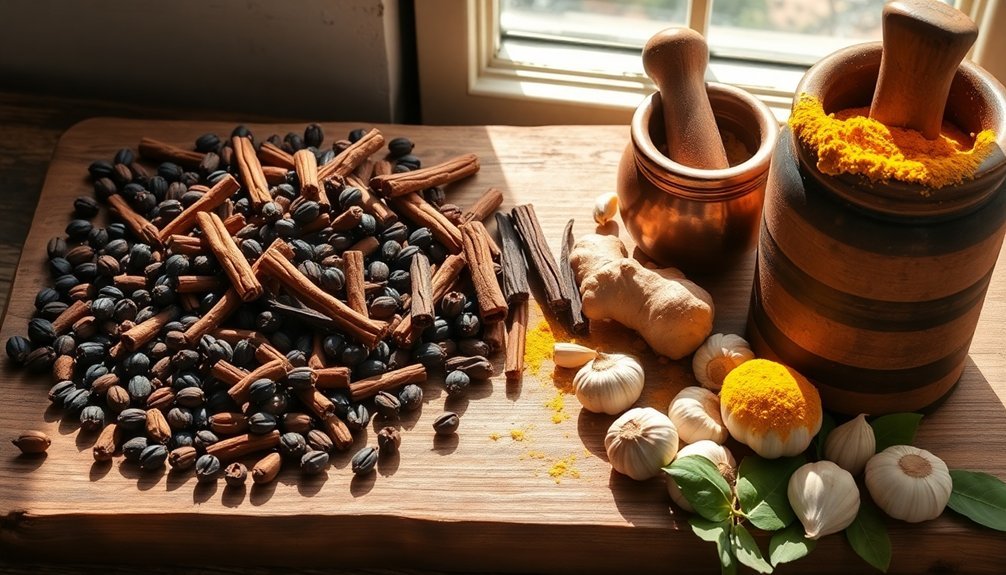
While modern preservation methods often rely on artificial additives, ancient food preservation techniques remain remarkably effective today. You'll find that many of these time-tested methods, such as using spices, salt, and sugar, continue to work just as well as they did thousands of years ago. The discovery of spontaneous fermentation processes helped ancient civilizations develop crucial food preservation techniques.
| Method | Ancient Use | Modern Application |
|---|---|---|
| Drying | Sun and wind drying in Middle East (12,000 B.C.) | Solar dehydrators, electric food dryers |
| Fermentation | Soured wine and beer preservation | Kimchi, sauerkraut, kombucha |
| Pickling | Indian cucumber preservation (3,000+ years ago) | Various vegetable pickles, relishes |
| Spice Curing | Egyptian and Roman food preservation | Marinades, rubs, natural preservatives |
| Sugaring | Roman fruit preservation with honey | Jams, jellies, fruit preserves |
You can easily incorporate these ancient methods into your modern kitchen. Try adding antimicrobial spices like garlic, oregano, and allspice to extend food's shelf life naturally. Combine multiple techniques for better results – for example, you might dry herbs with salt or create spiced preserves. These methods don't just preserve your food; they'll enhance its flavor and nutritional value while avoiding artificial preservatives.
Storing Spices for Maximum Benefits
Proper storage of your spices plays a key role in maintaining their preservative powers. To maximize their food-extending properties, you'll need to protect them from their biggest enemies: heat, light, moisture, and air.
Keep your spices in a cool spot between 50°F and 70°F, away from your stove and other heat sources that can degrade their active compounds.
Your choice of containers matters considerably. Opt for amber glass jars with airtight lids, as they'll shield your spices from damaging light while keeping moisture out.
Don't use plastic containers, as they won't provide adequate protection and can affect your spices' quality.
Here's what you need to track for ideal preservation:
- Temperature – maintain consistent cool conditions
- Light exposure – minimize direct sunlight contact
- Container seal – check regularly for tight closure
- Freshness timeline – monitor age and potency
Organize your spices systematically, keeping frequently used ones within easy reach. Label everything clearly, including purchase dates, so you'll know when it's time for replacement.
Remember that ground spices last 1-2 years, while whole spices maintain their preservative properties for 2-3 years when stored correctly.
Top Five Antimicrobial Spices
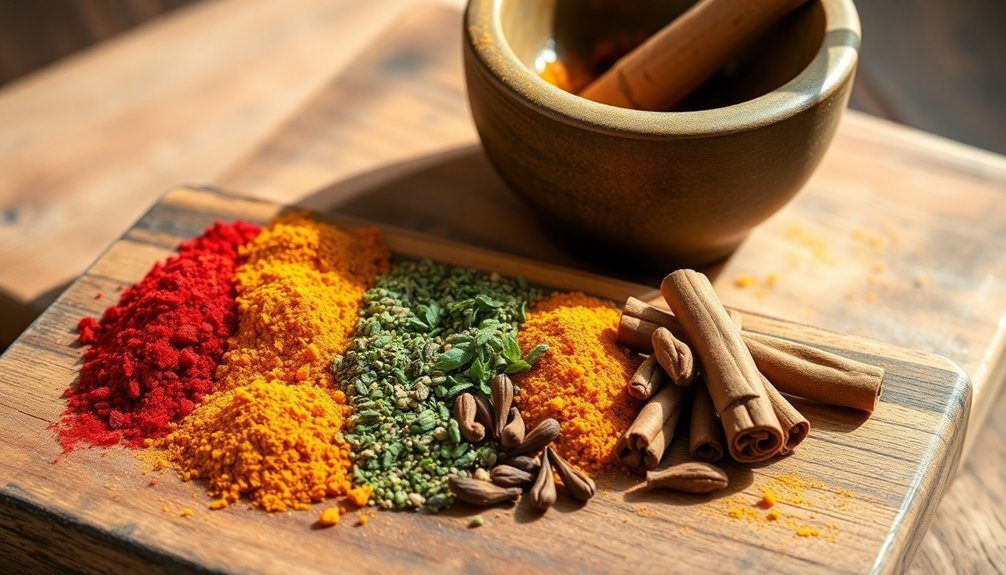
Nature's most powerful preservatives come in the form of five remarkable spices with potent antimicrobial properties. These kitchen staples – clove, garlic, cinnamon, thyme, and ginger – can help you maintain food freshness while adding delicious flavor to your meals.
You'll find clove to be particularly effective against E. coli and Staphylococcus aureus, thanks to its powerful essential oils. Garlic's allicin and sulfur compounds work by disrupting bacterial cell membranes and DNA, while cinnamon's cinnamaldehyde interferes with bacterial metabolism.
Thyme contains thymol, which prevents microorganism growth by disrupting their cell membranes and enzyme activity. Ginger rounds out the top five with its ability to inhibit various bacteria through its antioxidant and anti-inflammatory properties.
These spices have proven their worth throughout history. Ancient cultures used them extensively for food preservation – from clove's role in embalming to cinnamon's use in hot climates to prevent food spoilage.
Today, you can incorporate these spices into your cooking to naturally extend your food's shelf life while benefiting from their traditional preservation methods that have stood the test of time.
Making Natural Spice Blends
You'll find that creating shelf-stable spice blends starts with combining basic aromatics like black pepper, garlic powder, and paprika with preservative-rich spices such as turmeric and rosemary.
When crafting regional preservation blends, you can mix Mediterranean herbs like oregano and thyme for Italian-style combinations, or combine cumin, coriander, and chilies for Mexican-inspired preservative blends.
The key is to balance the natural preservative properties of each spice while maintaining authentic regional flavors that complement your preserved foods.
Basic Shelf-Stable Combinations
Creating your own spice blends at home can extend both shelf life and versatility while saving money compared to pre-packaged options.
You'll find that combining complementary herbs and spices not only enhances flavor but also helps preserve your ingredients when stored properly in airtight containers away from heat, light, and moisture.
For maximum shelf stability and flavor enhancement, consider these proven combinations:
- Mediterranean classics like basil, oregano, thyme, and rosemary work together to create a versatile blend that's perfect for tomato-based dishes and can last up to 6 months when stored correctly.
- Combine cumin, chili powder, garlic, and oregano to create a robust blend that'll enhance stored beans and legumes while extending their palatability.
- Mix coriander, cumin, ginger, and turmeric for a warming blend that transforms simple lentils and preserves their flavor.
- Create your own curry powder or garam masala blend using fresh-ground spices for ideal flavor and longevity.
Don't forget to label your blends with creation dates and store them in dark, cool cupboards.
You can also freeze fresh herbs like basil or create dried combinations like Herbes de Provence for long-term storage options.
Creating Regional Preservation Blends
Regional preservation blends offer a time-tested approach to extending food longevity while celebrating cultural flavors. You'll find that different regions have developed unique combinations of spices that not only preserve food but also create distinctive taste profiles.
To create Indian-style preservation blends, combine cumin, black pepper, and ginger. These spices work together to prevent bacterial growth while offering anti-inflammatory benefits.
For Mediterranean preserves, you'll want to focus on salt-based mixtures enhanced with black pepper and aromatic herbs.
When crafting your blends, remember to balance the flavors carefully. Start with salt as your base preservative, then add pungent spices like black pepper in moderation. You can layer in savory elements such as cumin, followed by more delicate aromatics.
The timing of spice addition matters – add robust spices early for deep flavor extraction, while saving delicate ones for finishing.
You'll get the best preservation results by understanding how each spice contributes. Salt draws out moisture, black pepper extends shelf life by up to a month, cumin prevents oxidation, and ginger adds antimicrobial properties.
Together, they create effective preservation blends that reflect regional cooking traditions.
Extending Meat Shelf Life
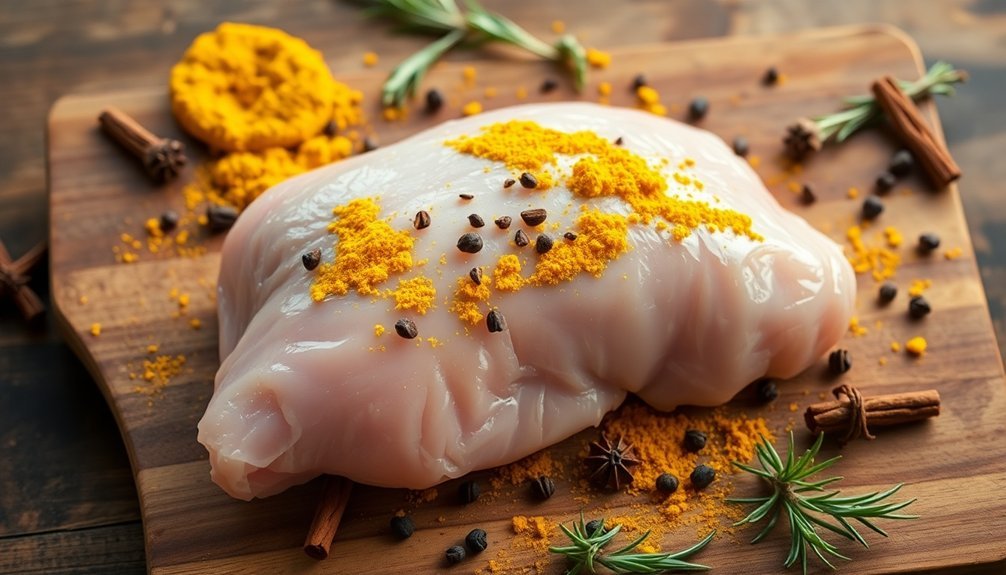
You'll find that combining powerful antimicrobial spices like thyme, rosemary, and cinnamon creates a more effective preservation blend than using single spices alone.
For poultry specifically, you can rely on a mixture of black pepper, garlic, and thyme to naturally inhibit bacterial growth and extend freshness.
When you're using salt-based preservation methods, you'll get the best results by pairing salt with herbs like sage or rosemary, which work together to draw out moisture while preventing bacterial growth.
Natural Antimicrobial Spice Blends
Natural antimicrobial spice blends offer remarkably powerful solutions for extending meat's shelf life, with some combinations proving more effective than individual spices alone.
When you're looking to maximize preservation, combining thyme with rosemary creates a particularly potent mix that outperforms either herb used individually.
The science behind these blends lies in their complementary antimicrobial compounds. You'll find thymol in thyme working alongside cinnamaldehyde in cinnamon, while oregano's carvacrol adds another layer of protection. These compounds work synergistically at controlled temperatures, especially at 2-4°C.
Here are the most effective antimicrobial spice combinations you can use:
- Thyme + Rosemary: Extends shelf life up to 60 days
- Clove + Cinnamon + Oregano: Creates a strong bacterial resistance
- Ginger + Thyme + Marjoram: Preserves meat for up to 21 days
- Thymus daenensis + Cinnamon + Rosemary: Enhances overall preservative effects
You can apply these blends through direct seasoning or by incorporating them into edible films and coatings.
For maximum effectiveness, use raw garlic when it's part of your blend, as heat diminishes allicin's antimicrobial properties.
Best Spices For Poultry
Preserving poultry's freshness requires specific spice combinations that target both flavor enhancement and antimicrobial protection. You'll find that traditional spice blends like Tandoori and Kalia can extend your chicken's refrigerated shelf-life by 3 to 6 days while maintaining its quality, color, and texture.
When you're looking to maximize preservation, combine thyme, rosemary, and sage – they're particularly effective against spoilage. Adding garlic and onion powder to your spice mix will boost its antimicrobial properties, while paprika and white pepper contribute to both preservation and flavor enhancement.
| Spice Combination | Preservation Benefit |
|---|---|
| Thyme + Rosemary | Up to 60 days shelf-life |
| Garlic + Onion Powder | Enhanced microbial protection |
| Tandoori Mix | Reduced bacterial load |
| Sage + White Pepper | Better moisture retention |
You'll get the best results by creating your own spice blends and storing them in airtight containers. These natural preservatives work by reducing lipid oxidation and inhibiting microbial growth, offering you a safer alternative to synthetic preservatives. Remember that combining multiple herbs and spices creates a more potent preservative effect than using them individually.
Salt-Based Preservation Methods
Salt stands as one of the most effective preservation methods for extending meat's shelf life. The process works through osmosis, where salt draws moisture out of the meat while simultaneously penetrating the tissue to create an environment hostile to harmful microorganisms.
You'll find that this dehydration process not only preserves the meat but also changes its texture and develops unique flavors through the formation of lactic acid.
When you're ready to preserve meat using salt, you can choose from several proven methods:
- Dry salting – Apply pure salt directly to the meat's surface, ensuring complete coverage.
- Brining – Submerge your meat in a saltwater solution for more even preservation.
- Salt box method – Place meat in a container while coating it thoroughly with salt.
- Salt packing – Create a protective salt crust around the meat.
After the initial curing period, you'll need to rinse the meat and pat it dry.
For long-term storage, hang your cured meat in a cool, dark place. If you find the meat too salty before cooking, simply soak it in water to reduce the salt content.
Remember to maintain proper storage conditions to maximize preservation effectiveness.
Fresh Herbs Versus Dried Spices
Understanding when to use fresh herbs versus dried spices can make a significant difference in your cooking results.
When you're working with delicate herbs like parsley, tarragon, and chives, you'll want to use them fresh since they lose their distinct flavors when dried. Add these to your raw dishes or at the end of cooking to maintain their bright, fresh taste.
In contrast, you'll get better results using dried herbs like oregano, marjoram, thyme, and rosemary in dishes that require longer cooking times. They're more concentrated, so you'll need less – generally, use 1 teaspoon of dried herbs for every tablespoon of fresh ones. Add dried herbs early in the cooking process to allow their flavors to fully develop in your sauces, stews, and soups.
For storage, keep your dried herbs in a cool, dark place where they'll last up to two years, though you'll want to replace them every six months for peak flavor.
Fresh herbs need refrigeration and will stay good for 1-3 weeks. Remember that while dried herbs are more cost-effective and have a longer shelf life, they won't always provide the same bright, fresh taste that fresh herbs deliver.
Regional Preservation Methods
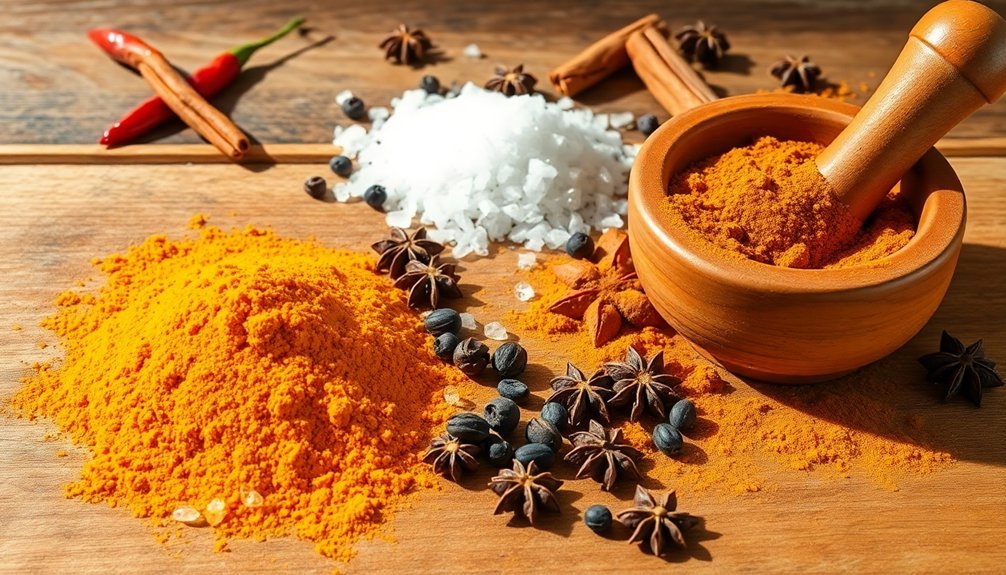
Beyond the choice between fresh and dried herbs lies a rich world of regional preservation methods that have stood the test of time.
You'll find these time-tested techniques woven into the fabric of cultural cuisines worldwide, each offering unique approaches to extending food's shelf life while enhancing flavor.
Indian cuisine showcases how spices serve dual purposes – they're not just for taste but also for preservation.
You'll discover that combinations of cumin, black pepper, saffron, and coriander work together to keep foods fresh naturally.
Korean culture has perfected fermentation techniques, particularly in kimchi, where spices play a vital role in both preservation and flavor development.
Consider these proven regional preservation approaches that you can adapt to your kitchen:
- Use oregano, cloves, and cinnamon to protect raw meats from spoilage.
- Combine salt-packing with aromatic herbs like rosemary and basil for longer-lasting freshness.
- Create fermented spice blends following Korean traditions for enhanced shelf life.
- Implement Indian-style spice combinations in your marinades to naturally preserve meats and vegetables.
These methods don't just preserve – they create deeper, more complex flavors while maintaining food safety naturally.
Modern Science Meets Traditional Wisdom
Recent scientific research has validated what our ancestors knew intuitively about spice preservation. You'll find that traditional methods like drying and salting are now backed by scientific evidence showing how they effectively control microbial growth and extend food's shelf life.
Modern science has revealed that spices like cloves and black pepper contain natural antimicrobial compounds that fight bacteria and fungi. These compounds work at concentrations between 0.5-4.0%, which perfectly aligns with typical cooking measurements. You'll notice that garlic, onion, and oregano are particularly effective at inhibiting foodborne pathogens.
Today's technology has enhanced these traditional preservation methods. You can now combine the antimicrobial properties of spices with modern techniques like vacuum packaging and modified atmosphere packaging. High-pressure processing and pulsed electric field technology offer new ways to preserve food while maintaining its nutritional value and taste.
If you're concerned about sustainability, you'll be pleased to know that spice-based preservation aligns with the growing demand for natural preservatives. It's an eco-friendly approach that reduces food waste while meeting consumer preferences for clean-label products.
Frequently Asked Questions
Can Spices Prevent Food Spoilage in High-Humidity Tropical Climates?
Yes, you'll find spices effectively prevent food spoilage in tropical climates. Antimicrobial spices like garlic, cinnamon, and cloves kill bacteria and fungi, while their antioxidant properties help preserve food in hot, humid conditions.
Do Spices Lose Their Preservation Properties When Cooked at High Temperatures?
Yes, you'll lose some preservation properties when cooking spices at high temperatures. While certain spices maintain heat-stable compounds, most will experience reduced antimicrobial and antioxidant effects through volatile oil degradation and polyphenol breakdown.
Which Spice Combinations Should Be Avoided When Preserving Different Foods?
You shouldn't mix cumin with cloves in meat preservation, ginger with mustard seeds in pickles, or black pepper with cinnamon in jams, as these combinations can reduce their individual preservation effectiveness.
Are Organic Spices More Effective at Preservation Than Conventionally Grown Ones?
You won't find significant differences in preservation effectiveness between organic and conventional spices, as their antimicrobial properties depend on the spices' natural compounds rather than farming methods. Both types work equally well.
How Do Electromagnetic Fields Affect Spices' Preservation Properties During Microwave Cooking?
When you microwave spices, electromagnetic fields activate their bioactive compounds while preserving antimicrobial properties. The rapid heating won't destroy their preservation abilities if you keep exposure times short and controlled.
In Summary
You'll find that many spices already in your kitchen cabinet can help preserve food naturally. Whether you're using cloves to protect meat, cinnamon to ward off mold, or salt for fermentation, these time-tested methods still work effectively today. By incorporating these powerful antimicrobial spices into your cooking and storage routines, you're not just adding flavor – you're extending your food's shelf life the way your ancestors did.

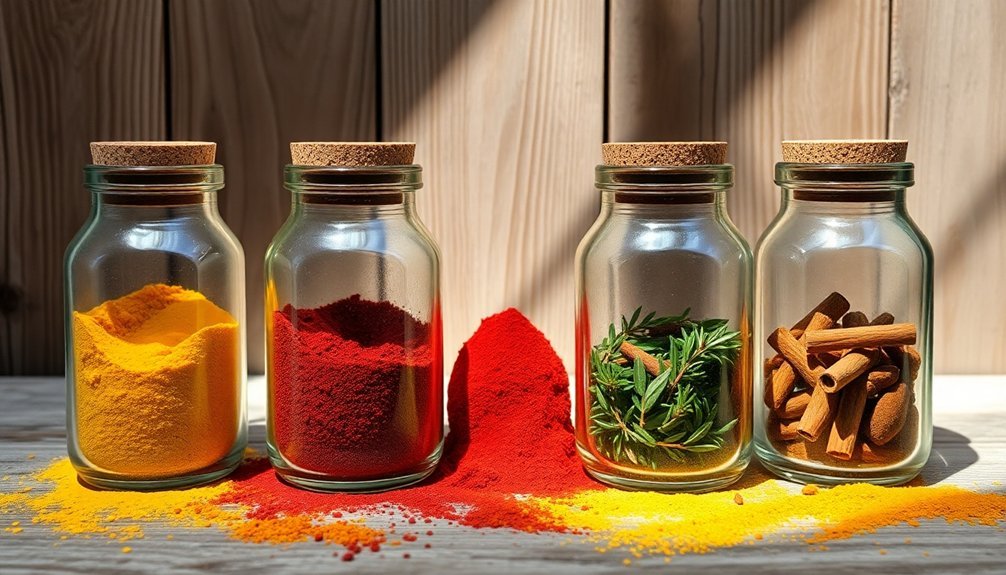



Leave a Reply